
Ford Puma Review

Introduction
Don’t call it a comeback - because while this car represents the second coming of the Ford Puma, it’s a different beast entirely to the one that first graced UK roads in the late Nineties. While the Puma of old was a small sports coupe, the new Puma is a compact SUV crossover that’s been ‘engineered to help you get the most out of today’s modern living’, according to Ford.
That means a bang up-to-date mild-hybrid power - with two of the three available engines featuring the tech. It also means lots of other gadgets, including Selectable Drive Modes, Adaptive Cruise Control, Pre-Collision Assist, and Evasive Steering Assist.
And with prices starting at £21,640, it’s competitively priced, too, sitting between the cheaper, £17,860 Nissan Juke and the £28,225 Audi Q2.
There is also one thing the new Puma has in common with the old Puma - people love them.
The first gen Puma exploded onto the scene in 1997 with a clever TV advert that saw a CGI Steve McQueen swapping his Mustang for one to race the mean streets of San Francisco. Others waxed lyrical about them, too, including the actor Ray Winstone who owned one, while Jeremy Clarkson and the Top Gear gang named it Car of the Year back in 1997.
Fast forward three decades and the all-new Puma, first unveiled last year, is once again winning accolades. In January it scooped the What Car? Award’s Car of the Year prize, with expert road testers saying it represents the best all-round package you can buy this year.
Judges were bowled over by its ‘sharp handling, gutsy engine and clever mild hybrid technology while describing how ‘it offers a mix of fun and frugality not previously seen among its competitors’.
It’s also as practical as it is stylish. What’s more, there’s a model for petrolheads, too.
In the good old days, the Ford Puma came in sporty ‘Ford Racing Puma’ guise, which boasted around 155 bhp and is now a bona fide classic. These days you can get the Puma in ‘ST’ trim, with 200 PS power, a limited-slip differential, and a 0 62mph acceleration time of just 6.7 seconds.
When it comes to the Puma, you just can’t keep a good cat down…
Review Sections
Select's rating score* - 4.0 / 5
At a Glance
The Puma is, then, marching to the beat of its own drum rather than harking back to the Pumas of the past. And while at first glance it’s hard to see the old Puma DNA, if you look stare a little closer you can see glimmers of the Nineties coming back through.
The distinctive bug-eye oval headlights remain, as do the high rear haunches and the gently bulging doors. The Puma line-up was also updated in June this year having first been released in 2019.
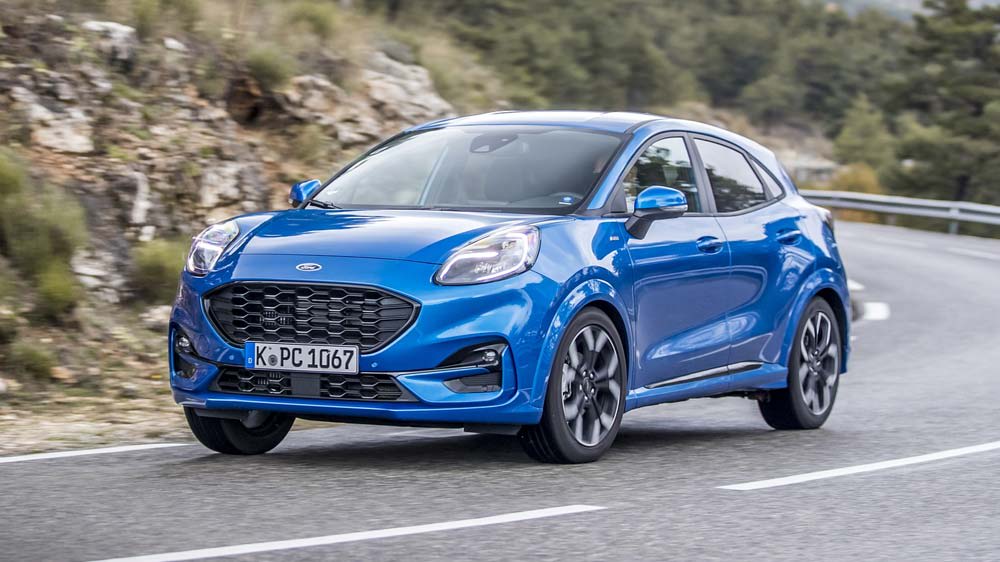
That means the option of a new seven-speed dual-clutch automatic transmission, as well as an all new Puma ‘ST-Line X Vignale’ variant. And the Puma is simply a pleasant place in which to park your posterior. An 8 inch touchscreen comes as standard while owners also enjoy Ford’s accomplished ‘SYNC 3’ infotainment system.
It’s surprisingly spacious for a small SUV crossover, with 456 litres of boot - much better than the 422 litres available with the Nissan Juke and the 402-litre Audi Q2.
Meanwhile the goodies available with even the standard ‘Titanium’ model are extensive - including leather steering wheel, lumbar massage seats, four selectable driving modes and LED daytime running lights.
And with Ford’s brilliant little 1.0 EcoBoost engine available, as well two punchy hybrid powertrains, the Puma also represents a winning mixture of sporty performance and wallet-pleasing frugality.
Key Features
You can opt for one of the four main versions of the Puma available - Titanium, ST-Line, ST-Line X and the ST-Line X Vignale - which get gradually more expensive as you climb the range, going from £21,460 to £25,240.
Titanium trim aims to keep ‘luxury’ at the forefront of minds, hence a leather steering wheel, gear knob and handbrake, as well as those massage seats and a wireless mobile phone charging pad. There’s also Automatic Headlights with Rain-Sensing Wipers and Auto High Beam
Electronic Air Temperature Control, rear parking sensors, as well as Electronic Stability Control (ESC) and Hill Start Assist. All in all, it’s a really impressive package in basic trim.
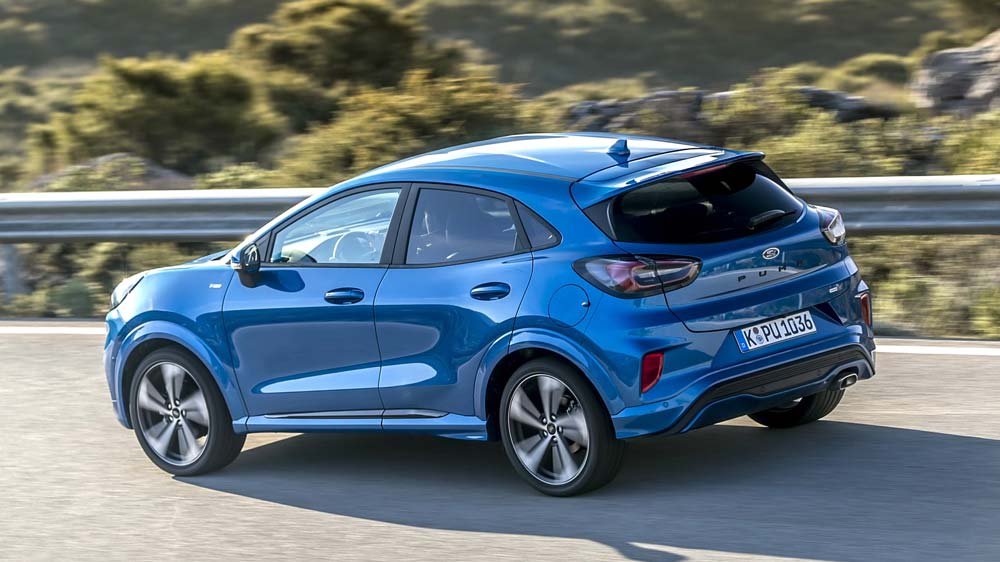
Move up to ST-Line, with prices starting from £22,590, and the Puma immediately looks different, thanks to a bodykit that includes a large rear spoiler and lower sports suspension.
The ST-Line Puma also gets a 12.3 inch digital instrument cluster, black 17-inch alloy wheels, swankier seats with better lumbar support and adjustability, as well as a flat-bottomed steering wheel.
Upgrade to ST-Line X, which costs from £23,690, and the offering is improved further. At this level you get 18 inch alloys, partial leather trim, rear privacy glass, Electronic Air Temperature Control (EATC) and a Bang & Olufsen sound system.
Meanwhile the high-end ST-Line X Vignale costs from £25,240 and in addition to the ST-Line X you get, among other things, Fixed LED headlights, a unique front grille, gloss black and chrome elements on the front and rear bumpers, premium leather seats, front parking sensors and keyless entry. All of these Pumas are front wheel drive and you can only enjoy the seven-speed automatic transmission with the 125 PS 1.0-litre EcoBoost engine.
The other two mills available - a 125 PS 1.0-litre EcoBoost Hybrid and a 155 PS 1.0-litre EcoBoost Hybrid - come with a six-speed manual gearbox.
And we shouldn’t forget the incoming Puma ST, set to cost £28,495, which was revealed in the last few weeks. Here you get exclusive green paint, bulging wheel arches, 19 inch alloys, Recaro seats, a rear spoiler, and a 200PS 1.5 litre EcoBoost engine.
Performance & Drive
The choice of engines available with the standard Puma might at first seem limited - there’s just three to choose from - but when they’re all based around Ford’s universally-loved turbo-charged 1.0 litre petrol EcoBoost mill, you’ll find very little to complain about. The first choice is, as you might have guessed, is simply that EcoBoost engine without any hybrid technology.
You get an ample 125 PS of power and it’s bolted to a seven-speed auto gearbox which has been optimised for ‘fuel efficiency, refinement and driving dynamics’, according to Ford. And it’ll send you down the road to reach 62mph in around 10 seconds. Your other options involve that same engine, but with the addition of Ford’s 48-volt mild hybrid technology, designed to improve efficiencies.
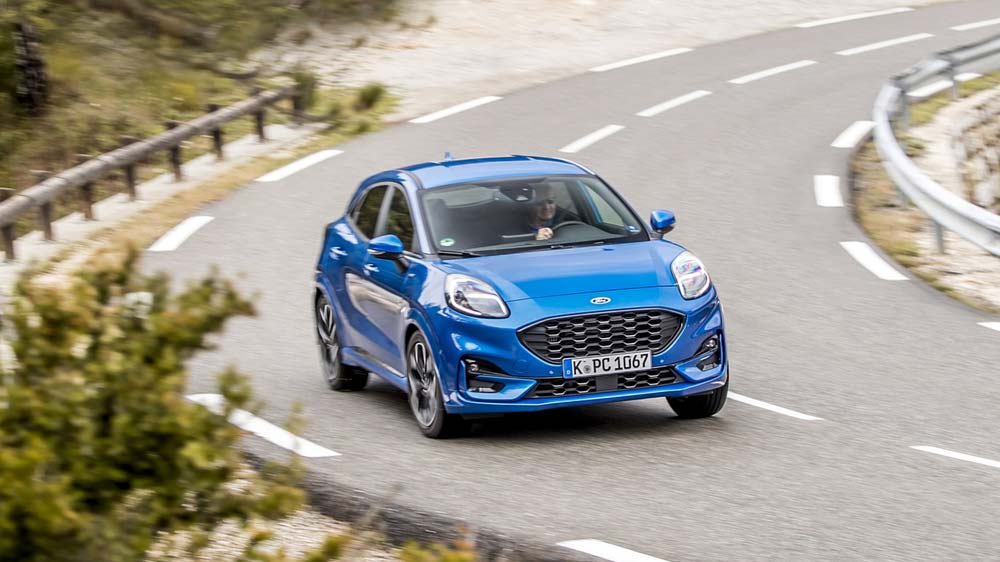
It comes in two guises - a 125 PS unit or a 155 PS engine. Interestingly enough, they both have exactly the same fuel economy figures. The 125 PS will reach 62mph in 9.8 seconds, the 155 PS shaves a second off that time with 8.9 seconds.
None of these figures is likely to worry a sports car. But that’s not what the standard Puma is all about. The Puma ST, however, is another thing entirely.
Here the 200PS 1.5 litre EcoBoost engine delivers a 0 62mph time of 6.7 seconds. Thanks to clever cylinder deactivation technology - which shuts down one of the engine’s three cylinders when it’s not needed - you’ll also save cash on fuel.
The sporty six-speed manual Puma ST can also be had with a limited-slip diff (LSD) - costing an extra £1,000 - to ensure you stay rubber-side down.
Running Costs
None of the engines available with the Puma - including in the Puma ST - are going to trouble your wallet when you visit the petrol station, as they’re decently economical. The non-mild hybrid 1.0 EcoBoost produces CO2 emissions of 138 g/km and will return around 45.6 mpg.
And, you’d expect, the two mild-hybrid mills are even more frugal, owing to the fact a small electric motor is used to assist the combustion engine. Because it doesn’t have to work so hard, it uses less fuel.
Both the 125 PS and the 155 PS mild-hybrids return 49.6 miles to the gallon and emit 127 g/km of CO2. That means you’ll spend around £150 a year on road tax.
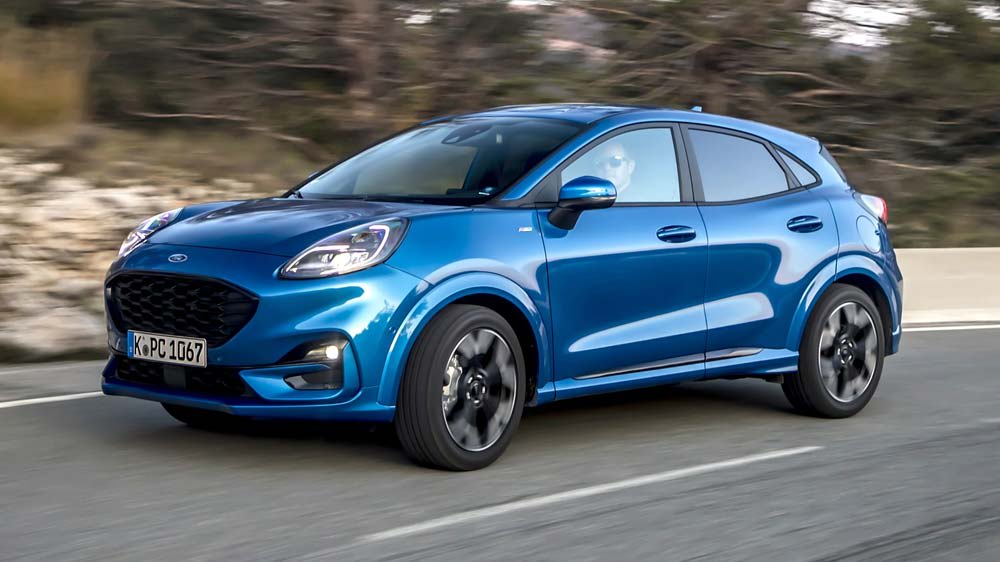
Meanwhile the Puma ST is also surprisingly stingy when it comes to using petrol. It returns 40.9mpg and chucks out CO2 emissions of 155g/km.
That’s not bad at all considering how rapid it is.
Some Puma owners might hanker for an even more efficient diesel engine, and there’s no plug-in hybrid expected any time soon following the recent suspension of Ford Kuga PHEV sales amidst an embarrassing battery recall.
Interior
Ford describes the interior of the Puma as being ‘seamlessly seductive’, and there’s certainly some eye-catching craftsmanship involved. Those lumbar-massage seats come in ‘Alhambra’ cloth in the basic Titanium model, but you get part-leather trim in both the ST-Line X and the ST-Line X Vignale.
And you can set your ideal cabin environment with Electronic Automatic Temperature Control, which is standard on the Titanium and ST-Line X models. The other important thing to note is the SYNC 3 infotainment system, which comes with an intuitive 8 inch touchscreen as standard.
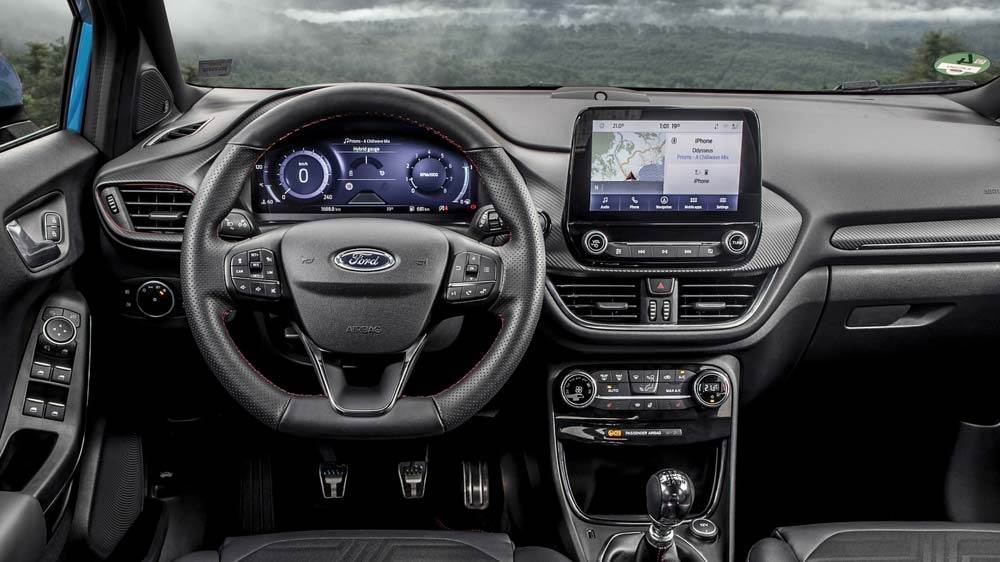
The SYNC 3 essentially connects your mobile phone to your car, letting you control everything from phone calls and text messaging to music and satellite navigation.
It’s compatible with Apple CarPlay and Android Auto, while the FordPass app and modem can tell you what the live traffic situation is, while also letting you check to see whether or not you remember to lock the car, and to jog your memory as to where you parked it.
A wireless mobile phone charging pad comes as standard on all models. Meanwhile an electrically-opened Panorama Roof is available as an option to ‘bring the world outside into the vehicle cabin’, costing £950, though it will eat into the rear headroom in the back.
Practicality & Boot Space
A mini SUV it might be, but the Puma is still surprisingly practical. There’s 1000mm headroom in the front, 965mm in the back, which compares favourably to the 1,029mm front/ 956mm rear figures of the Audi Q2.
Passengers get 877mm of legroom in the back, which again trumps the 815mm available in the Nissan Juke. Meanwhile shoulder room across the back is 1,320mm, which falls only slightly behind the Audi Q2’s 1,347mm.
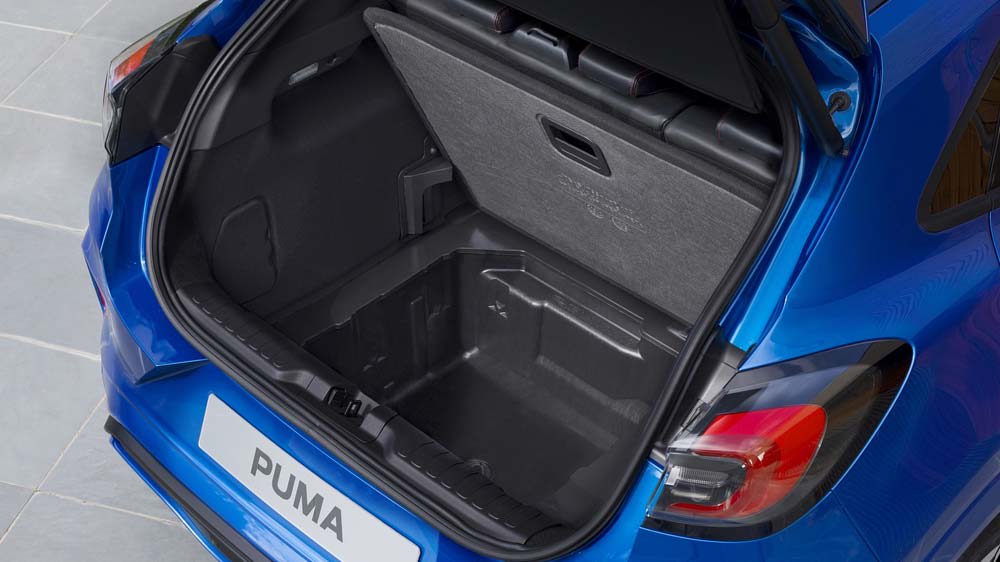
Room in the boot is also good for the segment - a 456 litre trunk placing it between the 422 litre boot Juke and the 402-litre Audi Q2.
The Puma also enjoys something called a ‘MegaBox’ - a sneaky compartment that sits beneath the boot floor, providing an extra 68 litres of space. Not only is it handy space to have, it’s also lined with waterproofing and features a drain hole, meaning it’s the perfect place to store your muddy wellies after an autumn yomp. And you can also opt for an automatic tailgate which opens when your leg performs a 'kicking motion' under the rear bumper.
Safety
Ford has made a big play about the Puma’s safety record, describing in December last year how it had become the latest model to receive a 5-star safety rating from the Euro NCAP independent crash test authority.
The Puma scored high for adult and child occupant protection – with full points in both the side barrier test and more severe side pole tests.
Technologies including Pre-Collision Assist with Active Braking, Intelligent Speed Limiter and Lane-Keeping System were also commended.
A Euro NCAP spokesperson added: “The standard-fit autonomous emergency braking system performed well in tests of its functionality at the low speeds at which many whiplash injuries occur, with collisions avoided or mitigated in all test scenarios.”
And depending which Puma model you choose, there’s a raft of driver assistance tech, including Adaptive Cruise Control with Stop & Go, Speed Sign Recognition and Lane Centring, Blind Spot Information System (BLIS) with Cross Traffic Alert, Enhanced Active Park Assist, Evasive Steering Assist and Wrong Way Alert.
Options
The Puma only comes in one colour as standard - ‘Blazer Blue’. All of the other nine colour choices, from ‘Race Red’ to ‘Grey Matter’, attract a premium of between £250 and £750.
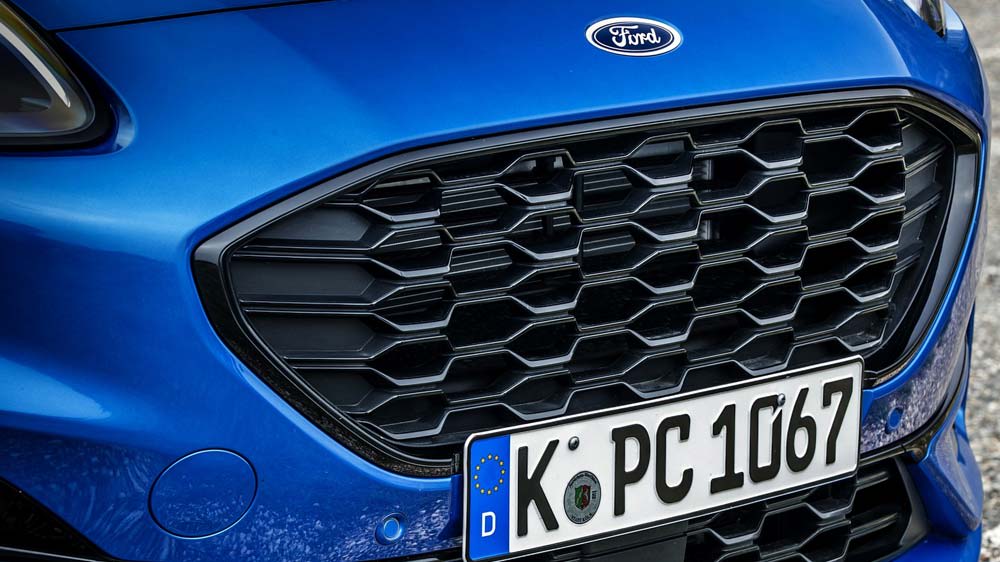
There’s the option of matt-black 19-inch alloy wheels with the ST-Line and ST-Line X, an upgrade on the 17 or 18 inch rims that come as standard.
The hands-free power tailgate is an extra £600 while rear privacy glass is £250.
The B&O audio system will cost you £450 and fixed LED headlamps are £800.
You can also opt for the £300 ‘Comfort Pack’, which gives you heated seats and a heated steering wheel, while the £900 ‘Driver Assistance’ pack includes extras like a rear view camera, front parking sensors and Autonomous Emergency Braking (AEB) via a radar and camera system.
Who Rivals The Ford Puma?
There might be plenty of compact small SUV crossovers to choose from, but there’s nothing quite like the Puma in terms of its styling.
In the ‘shrunken SUV’ corner you’ve got the likes of the £18,360 Volkswagen T-Cross, the sportier £18,605 SEAT Arona, the tidy £22,000 Mazda CX-30 or the luxury £28,225 Audi Q2.
And then in the ‘also looks a bit like a coupe’ corner you’ve got the ubiquitous Nissan Juke, as well as the £19,095 Renault Captur, the exceedingly quirky £19,190 Citroen C3 Aircross and the beautifully-designed DS3 Crossback, which costs from £22,515 and has arguably the best interior in the class.
If you’re looking for a plug-in hybrid, you might want to opt for the Renault Captur EV option, or wait for the upcoming Toyota RAV4 PHEV, which hits forecourts next spring, with pricing and spec to be confirmed later this year.
But whichever way you look at it, the mild-hybrid engines offered in the Puma offer both good efficiency as well as decent performance, and there’s an appeal to the unfussy, uncluttered approach to the powertrains available.
Verdict & Next Steps
When famous, once-forgotten marques return to forecourts, it’s fair to say it often produces mixed results.
We’re looking at you, Vauxhall Viva, an underwhelming small car revived in 2015 before being dumped from the line-up last year.
But when you get it right, as Ford has done with the Puma, the results somehow make a passing nod to nostalgia without really giving the past too much thought at all.
The Puma is, then, a wholly modern vehicle underpinned by the latest mild-hybrid technology and married to a 1.0 EcoBoost engine that has won an army of admirers.
The coupe like styling won’t appeal to everyone, and many families will crave the extra room a full-blown SUV might offer.
When you consider the competitors, however, the Puma is extremely well priced - particularly when you compare it to the Audi Q2, which is a good deal more pricey.
And you only need to take a look at the motoring awards the Puma is picking up to realise just how capable a machine it is.
Where to next?
- View latest Ford Puma car leasing deals - available from just £224.23 per month**
- Looking for a great car lease deal? Check out our incredible range of car lease deals
- New small SUV for the family? Read our latest Car Reviews including our Seat Arona Review or Volvo XC40 Review
- Want to know more about leasing? Take a look at our comprehensive Leasing Guides
- Interested in everything motoring? Why not catch up on all the latest Car Leasing News.
*Score based on Select’s unique meta score analysis, taking into account the UK’s top six leading independent car website reviews of the Ford Puma
**Correct as of 26/01/2022. Based on 9 months initial payment, 5,000 miles over a 48 month lease. Initial payment equivalent to 9 monthly payments or £2,018.07 Ts and Cs apply. Credit is subject to status.



















